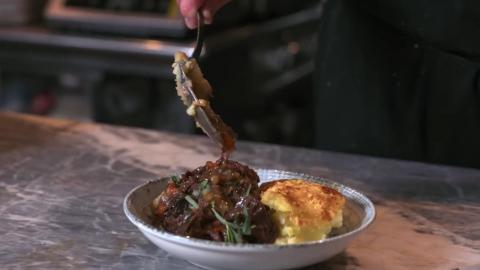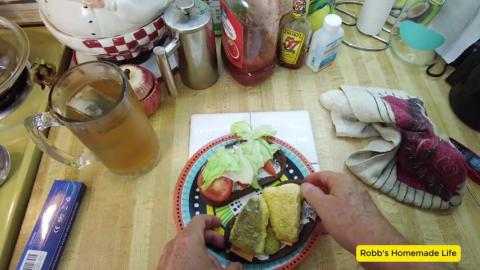Making Fresh Sauerkraut - Cabbage - The Food of the Gods!
2
0
22 Views
Published on 05 Jul 2022 / In
Film & Animation
Welcome to the series 7 premiere of 18th Century Cooking! We start things off by trying a delicious and easy Sauerkraut recipe right out of the 18th century!
Our Website - http://www.townsends.us/
Instagram - https://www.instagram.com/townsends_official//
Show more
0



 Life_N_Times_of_Shane_T_Hanson
Life_N_Times_of_Shane_T_Hanson
 Richie From Boston
Richie From Boston
 TheQuartering
TheQuartering
 Raging Golden Eagle
Raging Golden Eagle
 Gonzo Og
Gonzo Og

 Freshfit
Freshfit

 The David Knight Show
The David Knight Show



 GANG_STALKING_AUSTRLIA
GANG_STALKING_AUSTRLIA

 Donovan Sharpe
Donovan Sharpe
 Alpha Male Lifestyle
Alpha Male Lifestyle

 Styxhexenhammer666
Styxhexenhammer666



Log in to comment
Stolen Comments:
Lemmy Pop
5 years ago
You don't really need to chop cabbage head to make sauerkraut. The way we make it in Serbia: we core the cabbage head like an apple, and fill the hole with salt. We then put cabbages in a barrel (salt side up so it doesn't spill), and fill the barrel with water. Occasional stirring is required in the beginning of the fermentation, so that salt doesn't settle in the bottom. This way leaves stay firmer and crispier than in German style sauerkraut. Chop it, put some oil and paprika on it, and it's a wonderful side dish with roasted meats, for example.
Ken Jett
5 years ago
I helped grandma make hundreds of gallons of sauerkraut over the years. She had several 20 gal. crocks and we pickled everything I think. we made just as shown in layers ramping till juice came up then adding more. We did one extra added bonus though Hungarian wax bananna peppers just a few to each layer have it a touch of heat a little kick that really made difference in the flavor.
Kao Vamp
5 years ago (edited)
I'm Polish and my family always added cumin to sauerkraut in quite liberal quantities.
Anal0Avenger
3 years ago (edited)
5:08 I have used seasalt and iodized table salt, both have worked fine. I also put some chilis and red onion for taste and color.
Torvi Ironside
6 years ago
Being a "Kraut", born and raised and having grown up with Sauerkraut, needless to say that I LOVE this stuff! My grandpa used to put Kümmel (caraway seeds?) inside. I assume to aid digestion? My mother prepared it in rendered Speck (Bacon?) and served it with the cracklings mixed in, Bratwurst and mashed potatoes...
Vladimir A
5 years ago (edited)
Add some apples to cabbage while souring it. But use sour (sweet varieties not very usable for this) cultivars, in russia we often use Antonovka (one of better varieties of apple for this) or kinda of that. This sauerkraut may taste better and gonna have much more vitamins in it.
To do it just add one good midsized apple per two pound of cabbage.
Wash apple, clean it (peel skin off if you like). Slice to pieces about quart inch thick. Add apple slices between layers of cabbage after you mashed cabbage and waited 3-4 days (as you say to do after mashing). (sorry i don't remember exactly)
P.s. try to poke cabbage to the bottom with stick every day. This can make your sauerkraud less bitter.
Mike Benko
6 years ago
I have central European roots, where Sauerkraut is a staple with countless dishes. My grandmother and mother always used to prepare and store large amounts of it. I have grown up loving it. But over the years I have learned that not all Sauerkraut is created equal. A good one can be a light dish on its own, mixed with a bit of sunflower oil and eaten with bread. But much of the commercially available stuff, is simply bad, as they take the "Sauer" in the Sauerkraut too seriously and end up with extremely acidic and sour products (this is because they extremely often add catalysts to the product, instead of allowing a natural fermentation).
My grandmother also used to add things like Dill, Coriander, Black Pepper (whole), and Laurel leaves. These often substantially improve the taste of the Sauerkraut, without really altering its properties.
~~~~~~~~~~~~~~~~~~~~~~~~~~~
There are TONS of variations and varieties on Fermented Cabbage recipes.
A old Ukranian recipe of pickled/fermented cabbage used mainly in summer when the heat forbids making the classic sauerkraut.
The brine must have no more than 2% of acetic acid, it's an important point. With regular 6% white vinegar (check the pack), 1 part of vinegar, 2 parts of water or a bit more.
Salt 1% of the weight of cabbage. Sugar 1.5 to 2 %. Sugar cuts down acidity and improves pickling/fermenting, giving a sweeter taste. If you use cider or malt vinegar which have already sugar, you have to adjust the sugar at your taste.
Heat the water/ vinegar to dissolve the salt and sugar and take the flavor of the spices (mustard seed, ginger, pepper, etc at your taste). No need to boil. The brine will be used warm about 40°C 100°F, no more as this process will let ferment a bit the cabbage. You do not want to sterilize the cabbage.
You can use fine slices of carrots and onions with the shredded cabbage. Some add apple, but it's "dangerous" as some apples can become very mushy.
As on the video, compress the cabbage and the "secret" is to add a few spoons of oil. The oil will make a film on the surface et stop the oxidation of the cabbage. It's better to process by layers, adding cabbage, oil and brine and compressing it to be sure there is no bubble of air left.
Let it 12 to 24 hours at room temperature, and refrigerate after. The cabbage will be perfect the third day if you have the will of not to eat all before. After 3 days, the cabbage has given its water, but remains crunchy by just enough acidity.
Perfect in salads, sandwiches or cooked as a sauerkraut with sausage, pork etc..
It’s probably an important thing to know and utilize, because no one in their right mind wants to eat bugs or grubs to survive in the coming Democrat utopia. This being said, I find sauerkraut to be a putrid dish, with a smell somewhere between vomit and shit.
Bacon or sweet peppers makes it somewhat redeemable.